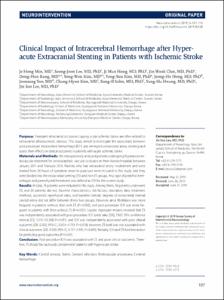Clinical Impact of Intracerebral Hemorrhage After Hyperacute Extracranial Stenting in Patients With Ischemic Stroke
- Alternative Author(s)
- Hong, Jeong Ho; Yoo, Joon Sang
- Journal Title
- Neurointervention
- ISSN
- 2233-6273
- Issued Date
- 2019
- Abstract
- Purpose:
Emergent intracranial occlusions causing acute ischemic stroke are often related to extracranial atherosclerotic stenosis. This study aimed to investigate the association between post-procedure intracerebral hemorrhage (ICH) and emergent extracranial artery stenting and assess their effects on clinical outcomes in patients with acute ischemic stroke.
Materials and Methods:
We retrospectively analyzed patients undergoing hyperacute endovascular treatment for cervicocephalic vascular occlusion in three Korean hospitals between January 2011 and February 2016. Patients who had extracranial artery involvement and were treated from 24 hours of symptom onset to puncture were included in this study, and they were divided into the extracranial stenting (ES) and non-ES groups. Any type of petechial hemorrhages and parenchymal hematoma was defined as ICH for the current study.
Results:
In total, 76 patients were included in this study. Among them, 56 patients underwent ES, and 20 patients did not. Baseline characteristics, risk factors, laboratory data, treatment methods, successful reperfusion rates, and baseline stenotic degrees of extracranial internal carotid artery did not differ between these two groups. However, atrial fibrillation was more frequent in patients without than with ES (P=0.002), and post-procedure ICH was more frequent in patients with than without ES (P=0.035). Logistic regression models revealed that ES was independently associated with post-procedure ICH (odds ratio [OR], 7.807; 95% confidence interval [CI], 1.213–50.248; P=0.031), and ICH was independently associated with poor clinical outcomes (OR, 0.202; 95% CI, 0.054–0.759; P=0.018); however, ES itself was not associated with clinical outcomes (OR, 0.530; 95% CI, 0.117–2.395; P=0.409). Notably, ICH and ES had interaction for predicting good outcomes (P=0.041).
Conclusion:
Post-procedure ICH was associated with ES and poor clinical outcomes. Therefore, ES should be cautiously considered in patients with hyperacute stroke.
- Department
- Dept. of Neurology (신경과학)
- Publisher
- School of Medicine (의과대학)
- Citation
- Je Hong Min et al. (2019). Clinical Impact of Intracerebral Hemorrhage After Hyperacute Extracranial Stenting in Patients With Ischemic Stroke. Neurointervention, 14(2), 107–115. doi: 10.5469/neuroint.2019.00108
- Type
- Article
- ISSN
- 2233-6273
- Appears in Collections:
- 1. School of Medicine (의과대학) > Dept. of Neurology (신경과학)
- 파일 목록
-
-
Download
 oak-2019-0372.pdf
기타 데이터 / 133.61 kB / Adobe PDF
oak-2019-0372.pdf
기타 데이터 / 133.61 kB / Adobe PDF
-
Items in Repository are protected by copyright, with all rights reserved, unless otherwise indicated.